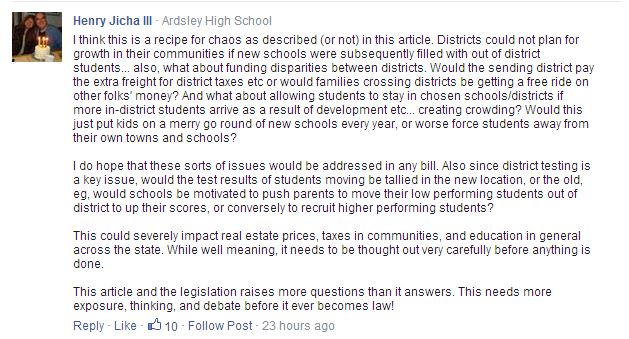Friday Freakout: Does Universal Public School Choice Result in Administrative Chaos?
Raleigh’s News & Observer published an article this week titled “NC bill would let students attend any public school” about a proposed bill that would allow open enrollment in North Carolina. The universal public school choice program would allow students to cross district lines without all the red tape and expensive fees parents must endure now.
The 40+ posts in the comments section of this article were overwhelmingly similar to one another, and that pattern inspired today’s Friday Freakout, or we should say freakouts.





Surprisingly, most people’s initial response to a program that would open doors to more school options for all kids was to worry about all the ways it might inconvenience school administrators.
Don’t get us wrong—troubleshooting is essential for anything new, from a school choice program to the latest tech gadget. In this case, the concerns of “chaos” and “impossible” administrative changes might have been valid had this bill been the first of its kind, but it isn’t. In fact, there are more than 21 states with open enrollment programs that haven’t imploded. North Carolina can, and should, look for creative implementation solutions from those states.
In fact, school administrators should be pleased this bill leaves how the program should be administered more open-ended. Perhaps that’s because government officials trust their school personnel’s professional abilities and expertise. After all, who has the most experience administrating and finding creative solutions for schools—school leaders or politicians?
To give this polarizing bill some perspective, let’s look at the district that inspired it: Colorado’s Douglas County School District, which has open enrollment and universal school choice vouchers. Only 0.7 percent of Douglas County students took advantage of their school choice voucher option, that’s 494 students out of more than 63,000. (By letting students access private schools, vouchers are different from open enrollment, which is limited to public schools; however, the intent—giving parents choice outside their zoned public school—is the same.)
Applying that percentage to North Carolina statewide:
- If 0.7 percent of all North Carolina public school students chose to attend a different district public school, we’re looking at around 10,000 students—not quite a floodgate compared to the state’s more than 1.4 million students.
- The state has more than 2,500 public schools.
- If all 10,000 kids were split among all the public schools, each school would have to accommodate four new students assuming none of their existing students leave. (Source: Public Schools of North Carolina Fast Facts)
- If 0.7 percent of all Wake County public school students chose to attend a different district public school, we’re looking at around 1,088 students out of 155,455.
- The county has 191 public schools.
- If all 1,088 kids were split among those public schools, each school would have to accommodate five new students.
- Let’s say only half of those schools are desirable to those out-of-district students. Those 95 schools would only have to accommodate about 12 new students each, again assuming no existing students leave. (Source: 2011-12 CCD data via ElSi)
In fairness, the actual outcome in North Carolina could be different from that example. But, ultimately, other states have shown opening up districts to parent choices is not going to result in uncontrollable chaos.
What many states with school choice programs find is that most families are content with their zoned schools. Universal public school choice is just an option for the few who might need it. We need to give our school leaders more credit for their ability to learn from other districts/states and determine sound implementation strategies for such a program. At the very least, they deserve a fair try before we start in on them.
In the end, a universal program like this can seem like an apocalyptic change that will bring calamitous consequences. But if we take a few moments to think it through, it’s not so intimidating. As the saying goes, “If you don’t like change you’re going to like irrelevancy even less.” Change is an inescapable given in life, so what matters is how one deals with it. We believe school leaders can, and will, rise to the challenge to serve families interested in their schools.




